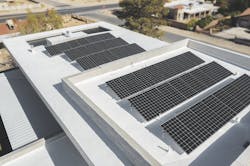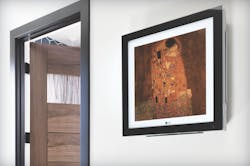What happens when a design and construction team embrace the latest best practices in high-performance building and remodeling? The New American Remodel (TNAR) seeks to answer that question. As such, it holds lessons for anyone wanting to satisfy today’s health- and energy-conscious homeowner.
The last few years have seen a great strides in home performance. Each version of the International Energy Conservation Code (IECC) inches closer to Net Zero Ready, which denotes a home that is so efficient that just a modest solar array will generate as much power as the homeowners use on an annual basis. The IECC obviously targets new construction, but some jurisdictions apply it to major remodels as well.
The 2020 TNAR team was determined to engineer a winner that would get ahead of that trend and show others how to achieve true Net Zero. Data indicates that they have succeeded.
Home performance and sustainability consultant Drew Smith of Two Trails has been part of the TNAR program every year since its inception and has also been on the New American Home team for a decade. Over that time he’s seen seen final test scores steadily improve.
One reason is the addition of solar, with this year’s home featuring a 14.6-kilowatt rooftop array from LG. Solar wasn’t part of TNAR as recently as 2018 but, according to Smith, “as the technology has become more affordable, we’ve made it a standard feature.”
Even without solar, the home would have earned a HERS score of 47—twice as efficient as the reference home
The solar array made it possible for the home to earn a HERS Index score of -17. The HERS Index compares home performance to that of an identical “reference” home built to the current energy code. The lower the score, the more comfortable and efficient the home, with the reference home given a score of 100, and a Net Zero home a score of 0 or less.
For Net Zero to be affordable the solar array needs to be cost-effective—which means making it as small as practical. That in turn requires a home so efficient that it doesn’t need much power. The New American Remodel certainly fits that description. Even without solar, according to Smith, the home would have earned a HERS score of 47—twice as efficient as the reference home, and a vast improvement over previous years. “Ten years ago our show homes were earning scores in the 60s,” he says.
This home is so efficient that, with the addition of a 14.6-kilowatt solar array, it was able to earn a HERS Index score of -17. That’s better than Net Zero.
Envelope Details
He credits those improved scores to three important developments: better envelope products, more efficient mechanical systems, and more knowledge on the part of designers and contractors about how to intelligently combine and fine-tune those products and systems.
With air leakage a major energy drain in most homes, Smith was determined to create a tightly sealed envelope. This is the second year he specified AeroBarrier, which he calls “Fix-a-Flat for homes.” Doors, windows, and duct grilles are taped off and the house pressurized with a blower door. Molecular-sized foam particles are then sprayed into the air and forced by that pressure into unsealed gaps. AeroBarrier can plug holes up to ¾ inch in diameter, and because the blower door constantly monitors results during application, the contractor can keep adding more spray until reaching the target air leakage.
In last year’s home, the final blower door test calculated air leakage at 2.5 air changes per hour (ACH) under a standard test pressure of 50 Pascals. That’s considered tight, but this year’s results were even better, with a final score of just 1.54 ACH. “Ten years ago we were getting air leakage numbers in the 4s and 5s,” says Smith. “Without AeroBarrier, we probably wouldn’t have been able to get this year’s home below 3.”
Cutting-Edge HVAC
The most obvious objection builders and remodelers have to enhancements like those detailed here is cost. But high-performance builders aim for cost neutrality, which means that savings on the monthly energy bill should equal or exceed the cost to finance the enhancements.
The mechanical system plays a big role in cost neutrality. With a tight, well-insulated building envelope, the HVAC contractor can specify a smaller heating system, which partially offsets construction costs. And choosing the most efficient system possible helps minimize those energy bills.
The home is heated and cooled with two Variable Refrigerant Flow (VRF) heat pumps from LG HVAC, each of which serves multiple indoor units for a total of nine zones. Indoor unit types include visible mini-split units, vertical air handlers in a mechanical room with ducts leading to common areas, and high-static ducted units that serve individual rooms and are hidden in the ceiling.
VRF technology has long been popular in Asia and Europe but is just now gaining traction in the U.S. Some experts see it as the wave of the future because it reacts more precisely to temperature and moisture loads. “A typical five-ton condensing unit gives you five tons no matter what you want, but a VRF unit will ramp up depending on the need,” says John Spargo of Comfort Engineering, Inc., the HVAC designer and installer. “That makes it very efficient.” He adds that VRF technology is also getting more versatile. “When it first became available in this country you couldn’t mix-and-match indoor units, but that has changed, giving the remodeler and builder more choices.”
VRF isn’t a panacea, though. The equipment still has to be correctly sized. Sizing is doubly important in a high-performance home where oversized equipment won’t run long enough to properly mix the air or—in humid climates—provide enough dehumidification.
That means the mechanical contractor needs to do a proper Manual J load calculation. Spargo says that this home’s results were indeed below industry norms, with a total sensible cooling load of 80,134 BTUH. Despite code minimums having gone up in recent code cycles, the load in a code-level home would still be about 20% higher.
Today’s VRF systems are flexible enough to accommodate a variety of indoor units. This home includes Vertical Air handlers in a mechanical room, high-static ducted units hidden in ceilings, as well as decorative wall-hung mini splits.
Setting Standards
The only way to get results like these is to make them a priority. Element has done that.
According to Moser, the company’s policy is that every home satisfy the entry-level requirements of at least one green building certification, regardless of whether the homeowner wants to fund the paperwork and testing to actually get it. “We believe this is the direction we’re moving as an industry,” he says. Certifications earned by the New American Remodel include the National Green Building Standard Emerald, LEED Platinum, Energy Star, and Indoor Air Plus.
While Element bought the home as a spec project, Moser knows from experience that future buyers will respond positively. “We tell every client about our standards and they always get on board. We haven’t come across client yet that didn’t want to be green or sustainable.”
He suggests that the builders or remodelers decide what standard they will build to and print out a line-by-line document detailing what’s required to meet it. “During the sales conversation you can tell the client, ‘We plan on meeting each of these line items,’” he says. “Of course you need to become very familiar with the list and need to be able to explain it clearly and to be ready to ask questions.”
About the Author
Charlie Wardell
Charlie Wardell is a freelance writer and former remodeler in Tisbury, Mass.




